Understanding the Essential Tool for Post-Mortem Eye Closure
Embalming eye caps are small, oval-shaped plastic devices with perforated surfaces designed to keep eyelids securely closed during the embalming process. These specialized tools restore natural eye contours and prevent the sunken appearance that occurs after death.
Quick Overview of Embalming Eye Caps:
- Primary Function: Maintain eyelid closure and restore natural eye shape
- Design: Oval shape with needle-pointed perforations and raised spurs
- Materials: Non-softening plastic or vinyl that resists chemicals
- Types: Clear or flesh-colored, available in small, medium, and large sizes
- Key Benefit: Bond to the eye on contact with moisture for secure placement
- Special Use: Suitable for eye donation cases and trauma situations
- Packaging: Typically sold in boxes of 24 or 144 pieces
For funeral directors and embalmers, eye caps are essential tools that ensure the deceased maintains a peaceful, natural appearance during viewing. The perforated surface and raised spurs work together to engage the eyelid tissue, while the flexible plastic material accommodates various eye shapes and sizes.
These devices become particularly important in cases involving eye donation, where they help fill voids and maintain facial symmetry. When used with emollient creams or disinfectants, eye caps provide reliable closure that won't shift during the preparation process.
The thin, flexible design allows eye caps to work effectively whether used dry or with moisture, making them versatile tools for different embalming techniques and case requirements.
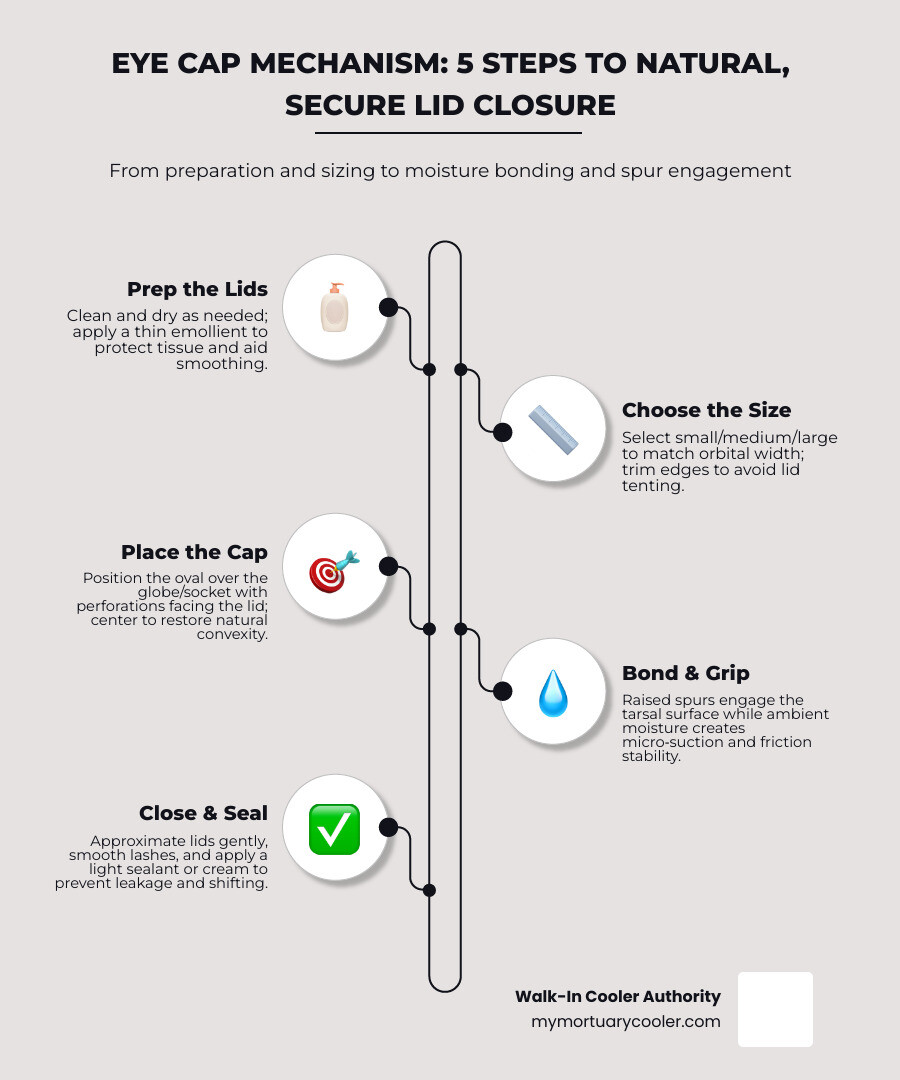
The Essential Role of Eye Caps in Post-Mortem Care
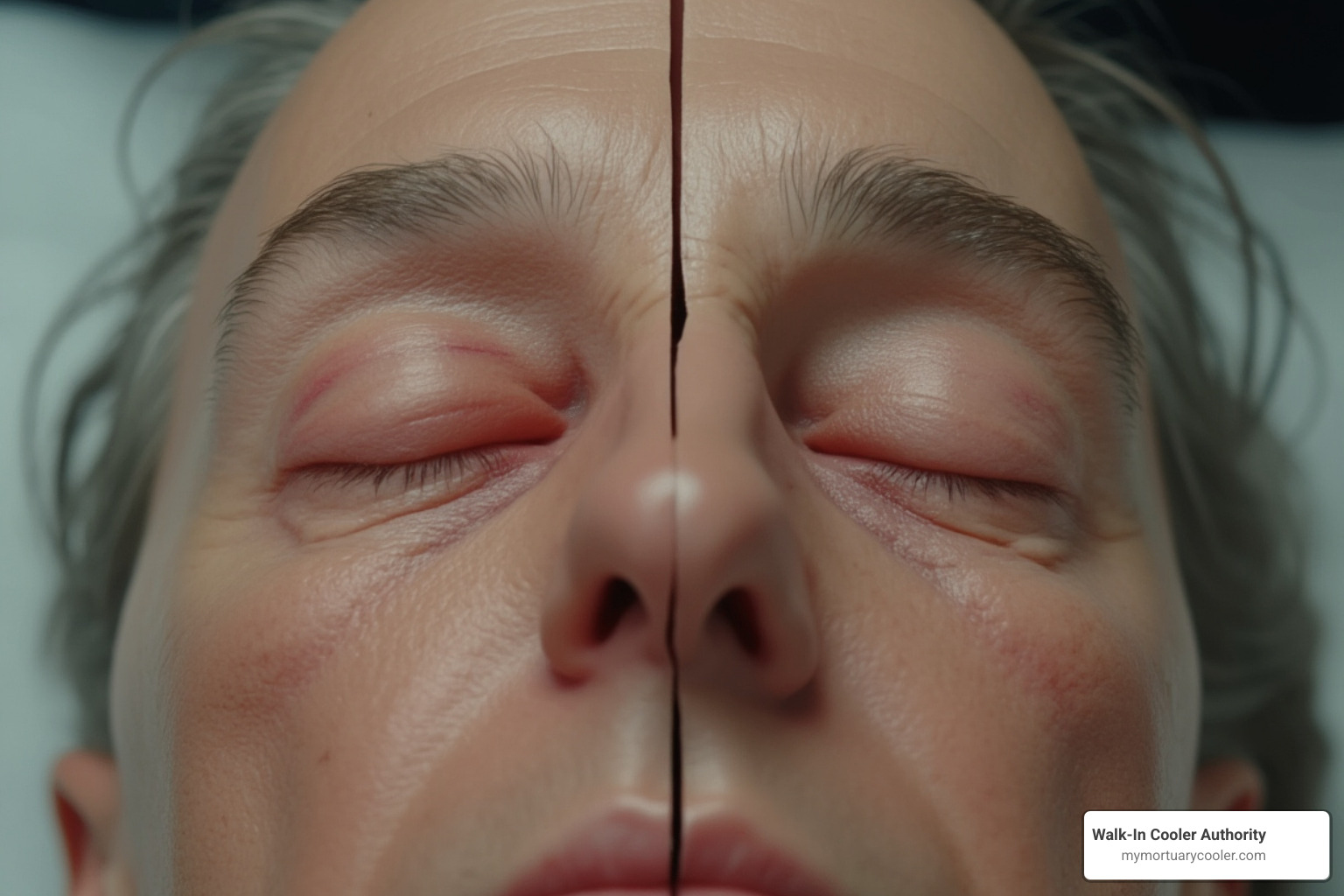
When families view their loved ones, the eyes are often the first feature they notice. A peaceful, natural appearance brings comfort during an already difficult time. Without proper eye closure, the deceased can appear uncomfortable or distressed—something no family should have to see.
Embalming eye caps play a crucial role in creating that peaceful expression. After death, the eyes naturally begin to dehydrate and lose their shape. The globe starts to flatten, causing the eyelids to sink inward and creating an unnatural, hollow appearance. This is where eye caps make all the difference.
These small devices work by providing a stable surface that allows eyelids to close evenly and naturally. They restore the natural globe contour so the eyes don't appear sunken or collapsed. The oval shape gently pushes the eyelids forward, compensating for the post-mortem flattening that occurs as tissues lose moisture.
Eye caps also support dehydrated tissues that might otherwise cause the eyelids to wrinkle or gap open. When paired with cavity fillers and gels, they help prevent fluid leakage while maintaining proper hygiene standards. Even when used with emollients or strong disinfectants, these devices remain securely in place throughout the entire preparation process.
To understand why eye caps work so effectively, it helps to know what's happening during embalming at the tissue level. The process chemically firms and stabilizes tissues while controlling moisture and microflora. For a deeper dive into that science, see The Science of Embalming: Chemistry, Microbiology, and Anatomy in Modern Preservation.
The Importance of Embalming Eye Caps for a Natural Appearance
The difference between using and not using eye caps is immediately visible. Secure closure creates that calm, peaceful expression that brings comfort to grieving families. Nobody wants to remember their loved one looking anything less than at peace.
The oval design gently pushes the eyelids forward, creating natural-looking contours that compensate for post-mortem tissue changes. Flesh-colored options blend seamlessly beneath thin eyelids, reducing any shadowing or shine-through that might look unnatural.
When used with cavity fillers or gelling agents, eye caps help fill voids left by tissue changes or medical procedures. This combination prevents fluid leakage while improving both the cosmetic appearance and hygiene of the preparation.
Perhaps most importantly, eye caps help ensure proper symmetry between both eyes. This guides accurate cosmetic application and reduces the need for corrective work later in the process. The result is a more natural, peaceful appearance that honors the memory of the deceased.
How Eye Caps Work: The Science of Secure Closure
The genius of eye caps lies in their simple yet effective design. The perforated surface features needle-pointed perforations that create just the right amount of friction against the underside of the eyelids. These tiny projections and holes work together to prevent slipping without causing any damage.
Raised spurs along the surface engage gently with the eyelid tissue, holding everything in place like tiny, gentle anchors. Many flesh-colored eye caps will actually bond to the eye on contact with moisture, creating even better adhesion without needing additional products.
The flexible plastic material is thin enough to conform to different eye shapes and sizes while remaining durable enough to maintain its position. This flexibility allows for subtle adjustments to achieve the perfect lid contour for each individual case.
These devices are made from chemically stable plastics that won't soften or break down when exposed to embalming fluids. They work effectively whether used dry or with emollient creams and strong disinfectants, giving embalmers flexibility in their techniques.
Want to see the texture up close? Here's a helpful visual reference showing the angled perforations: Visual example of eye cap perforations
A Closer Look at Embalming Eye Caps: Materials and Types
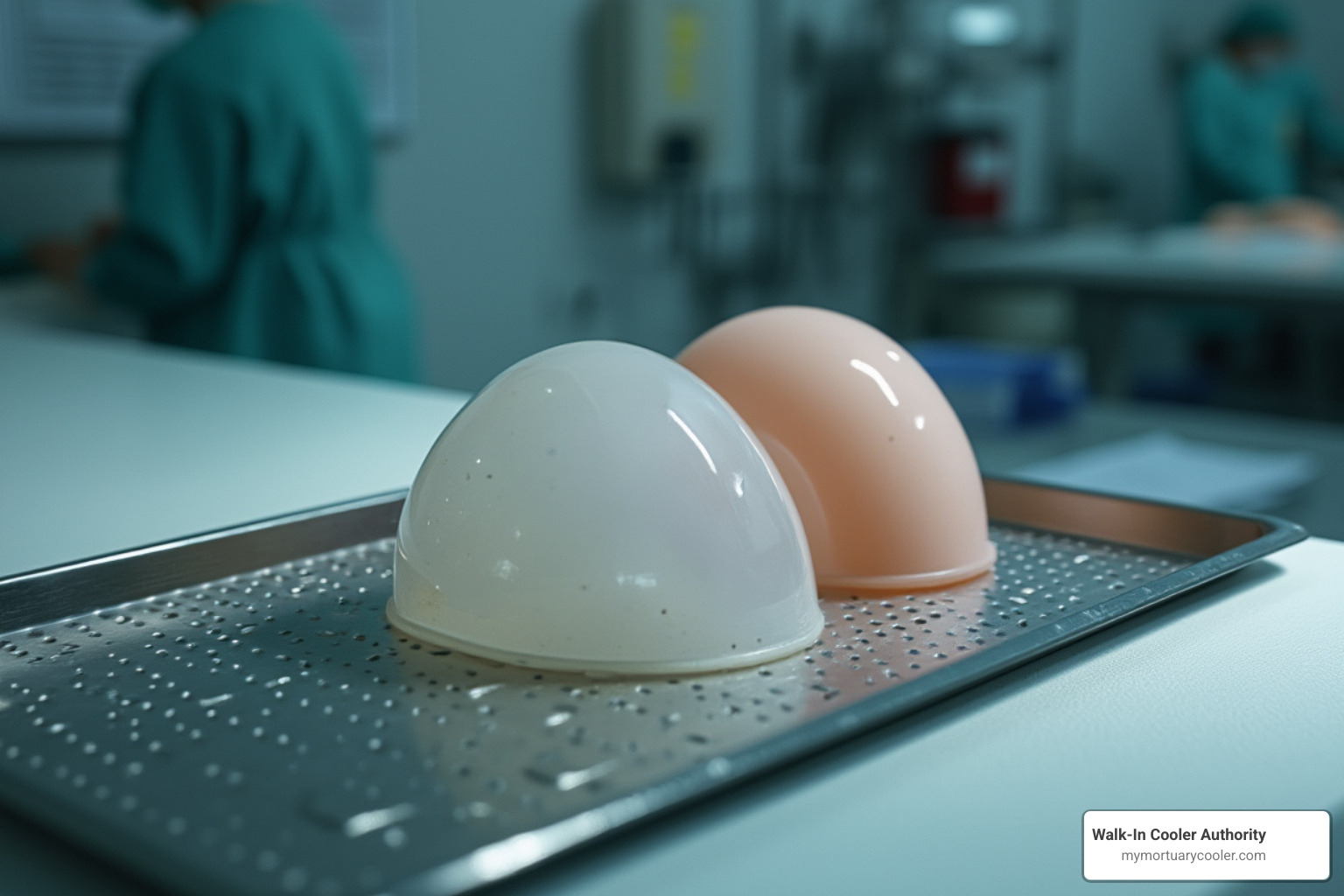
When you first look at different embalming eye caps, they might all seem pretty similar—that classic oval shape with the textured, perforated surface. But the small differences in materials and colors can make a real difference in how well they work for each case.
The foundation of any good eye cap starts with the material. You'll find caps made from non-softening plastic or vinyl that's specifically engineered to stand up to the harsh chemicals used in embalming. These materials won't break down when exposed to disinfectants, arterial fluids, or cavity treatments.
What makes these caps so effective is their thin, highly flexible design. This flexibility isn't just a nice feature—it's essential. It makes placement much smoother and more forgiving, reduces uncomfortable pressure points, and allows the eyelid to drape naturally over the cap.
The choice between clear and flesh-colored caps often comes down to the specific case. Clear caps are wonderfully discreet and work well when the eyelids are thicker. Flesh-toned caps, on the other hand, can prevent any show-through beneath thin eyelids, creating a more natural appearance.
Most suppliers offer these caps in small, medium, and large sizes to accommodate different anatomies. You'll typically find them packaged in boxes of 24 pieces for smaller operations or 144 pieces for busy prep rooms looking for economy.
For a comprehensive look at how eye caps fit into your complete toolkit of preparation instruments, check out A Practical Guide to Embalming Instruments and Their Uses.
Common Materials and Their Properties
Understanding the differences between plastic and vinyl eye caps can help you choose the right tool for each situation.
Plastic eye caps tend to be extremely thin and flexible, with excellent chemical resistance that keeps them stable even with strong disinfectants. They work beautifully whether used dry or with emollient creams, and the flesh-colored versions often bond naturally on contact with moisture.
Vinyl eye caps offer similar flexibility but with a slightly different feel—some embalmers describe them as having a "grippier" texture. Like their plastic counterparts, they're impervious to chemicals and work well with both dry and cream applications. Vinyl variants sometimes rely more on surface friction rather than moisture bonding for their hold.
| Feature | Plastic Eye Caps | Vinyl Eye Caps |
|---|---|---|
| Flexibility | Thin and extremely flexible | Flexible with slightly "grippier" feel |
| Chemical resistance | Impervious; will not soften with strong disinfectants | Impervious; designed for use with disinfectants |
| Use with emollients | Works dry or with creams | Works dry or with creams |
| Moisture bonding | Flesh-colored styles often bond on contact | Some vinyl variants rely more on surface friction |
| Durability in storage | Stable in standard prep-room conditions | Stable in standard prep-room conditions |
| Visibility under lids | Clear or flesh options; flesh shows less under thin lids | Often flesh-toned; low show-through |
Both materials store well in standard prep-room conditions and maintain their properties over time. The key is to verify compatibility with your preferred creams, gels, and disinfectants, as specific performance can vary between manufacturers.
Choosing the Right Embalming Eye Caps for the Job
Selecting the perfect eye cap really comes down to understanding the anatomy you're working with and the specific conditions of each case.
Size selection is your first consideration. Small caps work best for pediatric cases, emaciated adults, or anyone with naturally shallow orbits. Medium caps handle most average adult cases beautifully. Large caps are your go-to when working with fuller features or when you need that extra contour to achieve a natural appearance.
Color choice depends largely on the eyelid thickness and skin tone. Clear caps are the neutral choice that avoids any color tinting—perfect when the lids are thicker and won't show through. Flesh-colored caps minimize any show-through effect and often look more natural beneath thin or translucent lids.
The classic oval shape with needle-pointed perforations and raised spurs remains the gold standard for secure eyelid engagement. This tried-and-true design provides the friction and hold you need while remaining gentle on delicate tissues.
Special case considerations require some extra thought. For eye donation or enucleation cases, you might want to size up if you need additional volume, and always consider pairing with cavity filler to prevent collapse and control leakage. Trauma or edema cases might need you to size up or down to balance damaged tissue—rely on the cap's flexibility to achieve that smooth lid lay you're after. With dehydration cases, combining eye caps with emollients helps protect fragile lids and improves the overall drape.
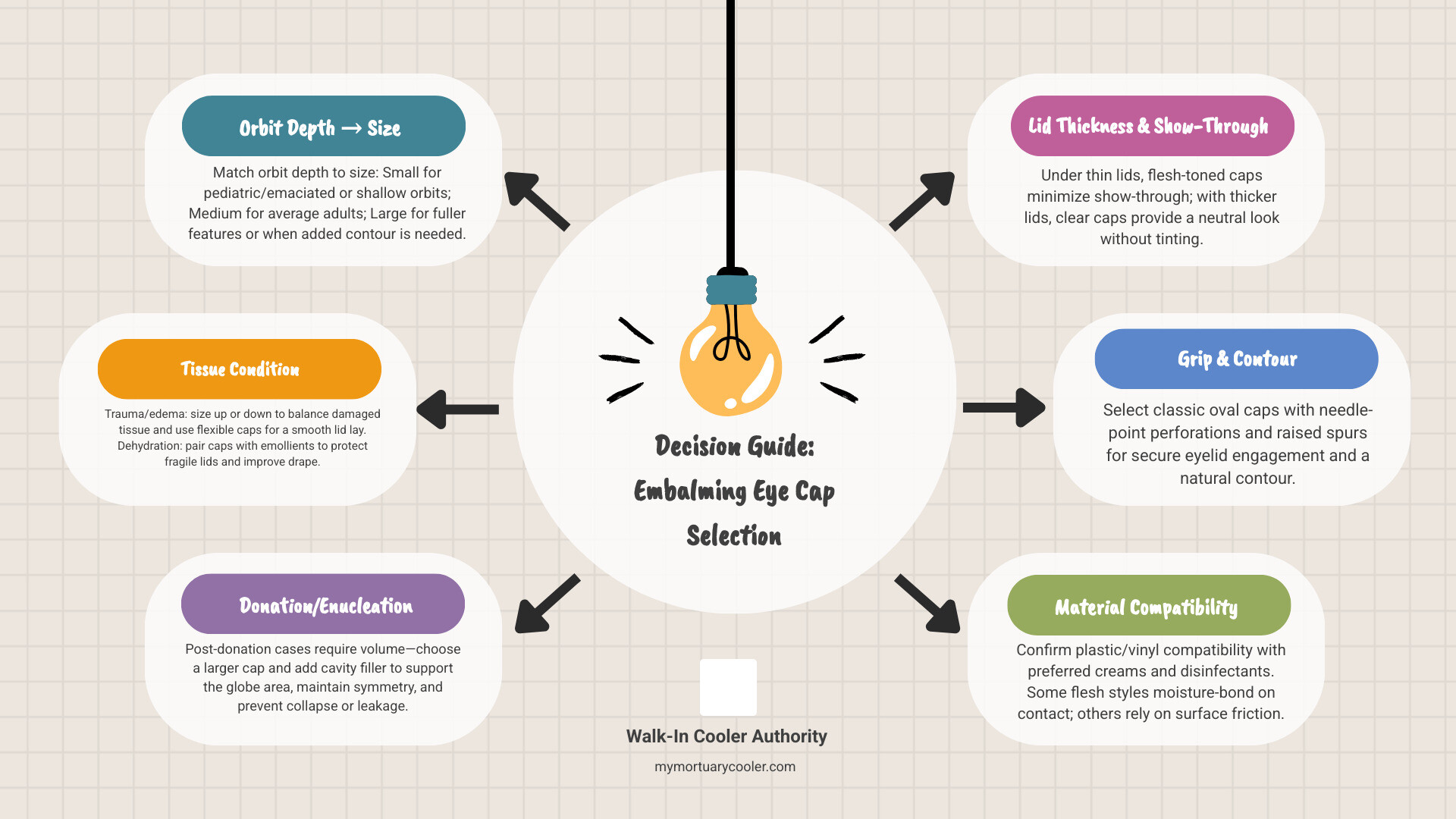
The Application Process: A Step-by-Step Guide
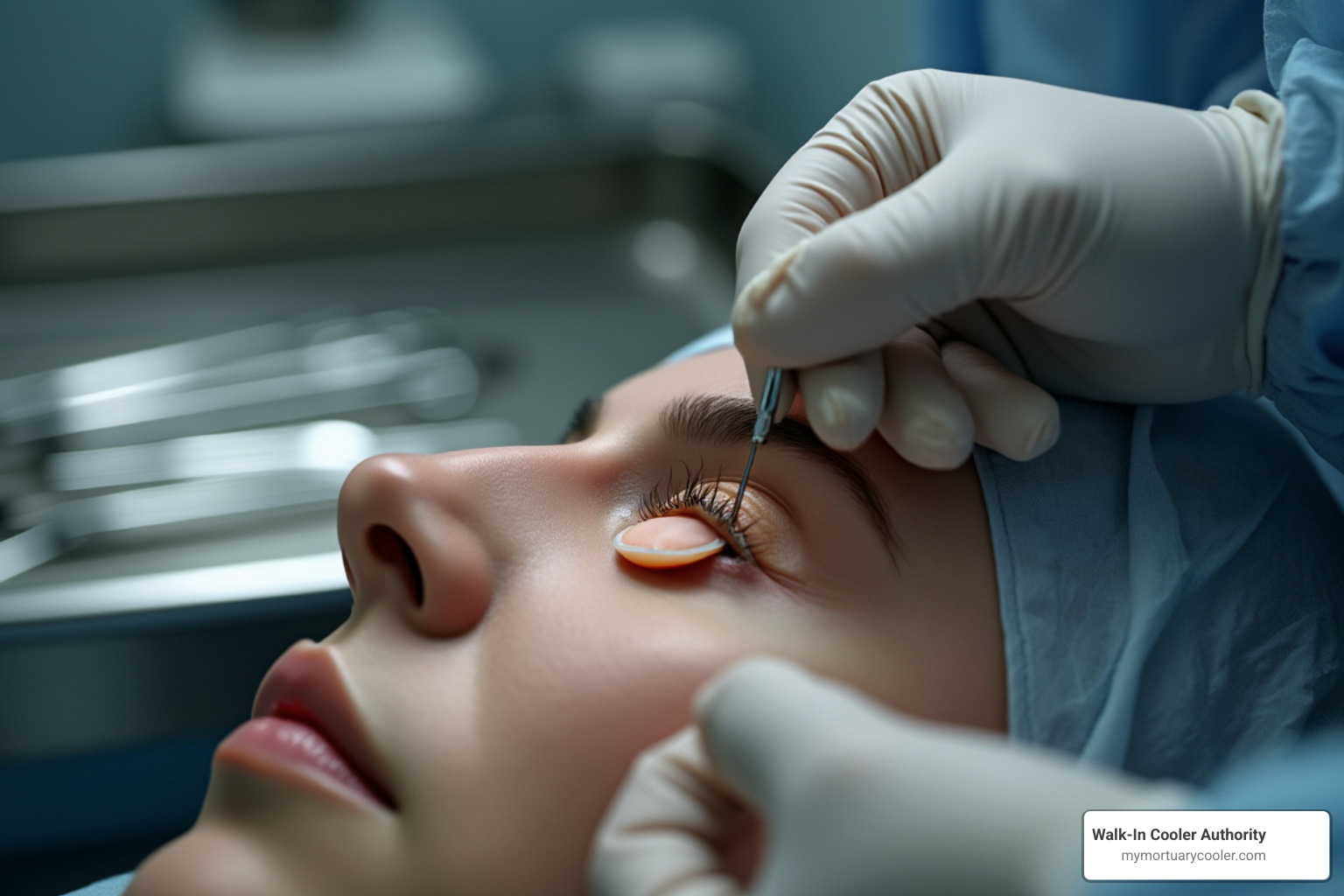
Getting embalming eye caps placed correctly makes all the difference between a natural, peaceful expression and something that looks "off." The good news? With a consistent approach, you'll achieve reliable results every time.
Start by preparing the orbital area with proper disinfection and gentle cleansing. Take a moment to assess what you're working with—is this a standard case, or are there special considerations like tissue damage or eye donation? This initial assessment guides your entire approach.
Moisture management comes next, and it's more important than many realize. If you're using flesh-colored caps designed to bond with moisture, a light dampening of the ocular surface helps secure placement. For dry or fragile eyelids, a thin film of emollient cream along the lid margins prevents wrinkling and improves how the lids drape naturally.
Size selection should err on the conservative side. Choose the smallest cap that restores natural contour without making the eyes look overly prominent. A quick test-fit by placing the cap over the area confirms proper centering before you commit to the placement.
The actual placement requires a gentle touch. Using either a gloved finger or an aneurysm hook, lift the upper lid and slide the cap into position so the perforations and raised spurs will engage the underside of the lids properly. Center the cap's long axis with the natural eye opening for the most realistic appearance.
Lid closure follows a specific sequence that prevents gaps. Bring the upper lid down first, allowing those needle-pointed perforations to gently grip the lid's inner surface. Then close the lower lid, smoothing it upward into natural contact with the upper lid. A light massage along the lash line ensures full, even closure without any telltale gaps.
Fine-tuning the contour often separates good work from great work. If the eye appears too flat, consider sizing up or adding a small amount of cotton or cavity filler behind the cap. If it looks too full, size down or redistribute any filler you've used. Subtlety always looks more natural than over-projection.
The final step involves securing everything in place. For cases with high leakage risk, pair your eye cap with compatible gel or bulk cavity filler to absorb fluid and prevent cosmetic problems later. Always do a final check for lid symmetry and proper alignment at the eye corners.
For insights on creating an efficient workspace that supports smooth application techniques like this, check out The Ultimate Guide to Embalming Rooms: What You Need to Know.
Special Cases: Eye Donation and Trauma
Eye donation cases present unique challenges that eye caps handle beautifully. Whether you're dealing with corneal excision or complete enucleation, the cap helps re-establish natural contour when you might otherwise struggle with collapse or asymmetry.
Consider using a larger cap size for donation cases, and back it with cavity filler to fill voids completely. The non-softening plastic construction means your caps stay stable even with strong disinfectants and gels commonly used in these situations.
Maintaining symmetry becomes critical when only one eye has been affected. Take measurements from multiple angles to ensure both sides project equally. It's one of those details that families notice immediately, even if they can't articulate why something looks wrong.
Trauma cases require extra gentleness and flexibility. Choose highly flexible caps that won't pressure fragile or damaged tissue. Liberal use of emollients reduces friction and prevents additional trauma to already compromised skin.
When edema or swelling is present, size carefully to avoid creating an unnaturally prominent appearance. Sometimes what looks like the right size initially becomes too much projection once swelling subsides during the preparation process.
Dehydration cases benefit from that combination of emollient and proper cap engagement. Make sure those perforations are fully gripping the lid tissue to prevent separation later. Flesh-colored caps work particularly well here, reducing any hint of shadow or artificial appearance under thin, dehydrated lids.
Potential Issues and Best Practices
Sizing mistakes cause most problems with eye cap application. A cap that's too large creates that unsettling "staring" expression, while one that's too small allows lids to gap open. Always test-fit before committing to placement.
Eyelid separation typically shows up first at the inner corners of the eyes. This medial canthus area deserves special attention during your final inspection. If lids separate during cosmetic application, you can usually fix it by gently smoothing the lid back over the cap to re-engage those perforations.
Cap shifting happens most often on dry, slippery surfaces. A light touch of moisture or emollient prevents this movement without creating mess or interfering with later cosmetic work. Those flesh-colored caps that bond on contact with moisture provide extra security in challenging cases.
When you need removal or repositioning, resist the urge to yank or force anything. Lift the upper lid gently and ease the cap forward, then re-center and re-close with the same care you used initially.
Creating an effective moisture barrier becomes essential in high-leakage cases. Combining your eye cap with absorbent or gelling agents creates a reliable barrier that maintains cosmetics longer and prevents unpleasant surprises during viewing.
Sourcing and Professional Considerations
When you're running a busy prep room, having the right supplies on hand makes all the difference. Embalming eye caps are one of those essentials you don't want to run out of mid-case, especially when you're working with families who deserve your best work.
Most funeral professionals keep multiple sizes and both clear and flesh-colored options stocked in their supply rooms. It's one of those "better to have it and not need it" situations—you never know when a case will require a specific size or color option.
Typical packaging comes in two main formats: 24 per box for smaller operations or those just getting started, and 144 per box for high-volume prep rooms that want to buy in bulk and save money. The larger boxes are particularly popular with busy funeral homes that handle multiple cases daily.
Price-wise, you're looking at reasonable costs for such an essential tool. Based on current market conditions, 144-count boxes typically range from the low-to-high $20s—often around $23.60 to $27.00 per box of 144 pieces. You might find occasional sale pricing that drops below that range, and prices can vary depending on size, color choice, and vendor policies.
When evaluating suppliers, look for non-softening plastics that can handle the chemical environment of your prep room. The best eye caps are designed to work with strong disinfectants and function equally well whether you use them dry or with emollient creams. If you're considering flesh-colored options, confirm whether that particular model bonds on contact with moisture—it can make a real difference in secure placement.
At Walk-In Cooler Authority, we understand that success in funeral service comes from having reliable equipment and supplies when you need them. As America's trusted authority in mortuary and funeral supplies, we provide everything from OSHA-compliant refrigeration and autopsy equipment to the small but crucial tools like eye caps that make restorative art possible.
We sell direct to professionals, which means you save money while getting the quality supplies your families deserve. Our distribution network covers the entire USA and Canada, with support reaching from Johnson City, TN to Los Angeles, CA, and everywhere in between—including Atlanta, Chicago, Columbia, Dallas, New York, and Pittsburgh, plus all the Pacific, Midwest, Rocky Mountain, Southwest, Southeast, and Northeast regions.
To see how eye caps fit into a complete prep room setup, explore our comprehensive guide: Mortuary Equipment, Funeral Supply Solutions: Stretchers, Coolers, Racks, and Grossing Stations.
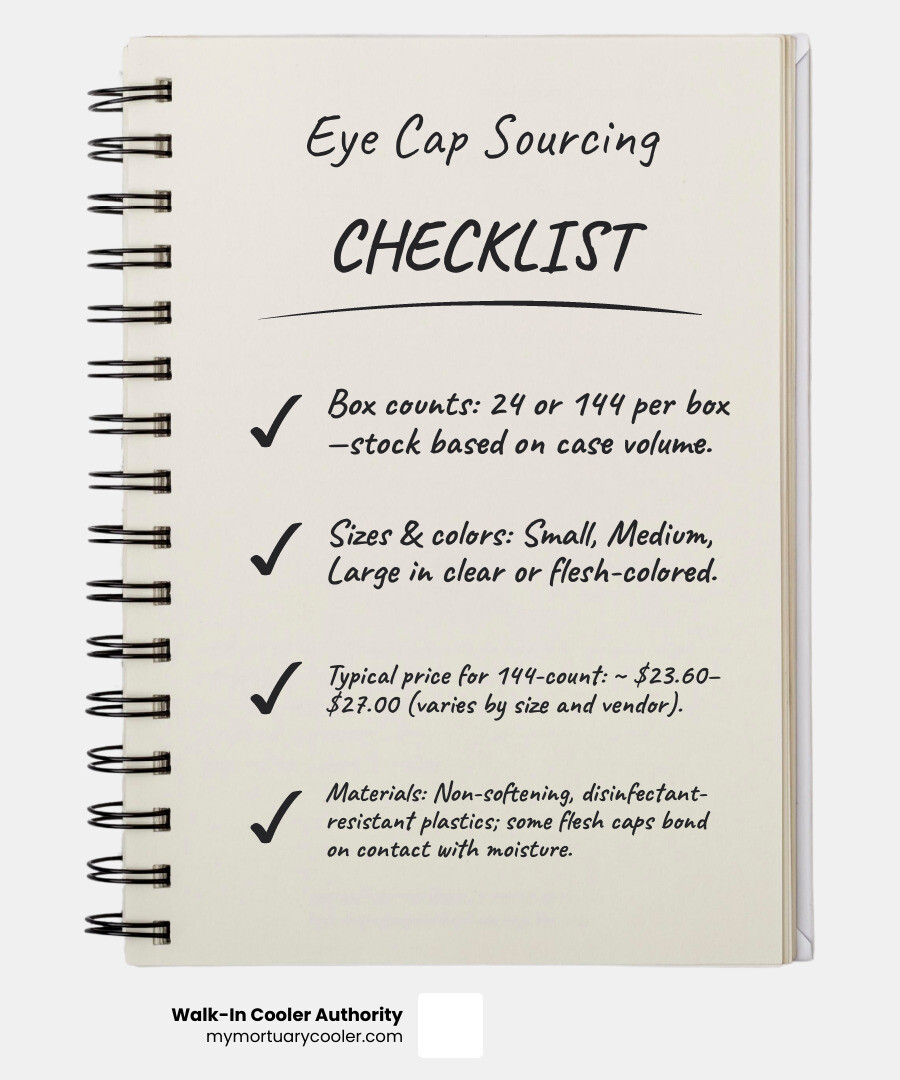
Conclusion
Embalming eye caps might be small tools, but they make all the difference in creating that peaceful, natural appearance families need to see. When you get the technique right—using the proper size, placing them securely, and letting those perforated surfaces do their work—you're giving families a gift they might never fully realize they received.
The science behind these simple devices is surprisingly neat. The perforated surface grips gently while raised spurs keep everything in place. Flesh-colored options bond naturally with moisture for extra security, while the chemical-resistant plastics hold up beautifully whether you're working dry or with your favorite emollients and disinfectants.
For challenging cases involving eye donation or trauma, these caps become even more valuable. Pair them with cavity filler to restore volume and prevent leakage, and you can maintain the symmetry that keeps everything looking natural. It's remarkable how such a straightforward tool can solve so many presentation challenges.
We understand that getting every detail right matters deeply in this profession. That's why Walk-In Cooler Authority stocks the prep-room essentials professionals count on—from the smallest eye caps to complete mortuary refrigeration systems. As America's direct seller of OSHA-compliant funeral equipment, we're here to support your work across the USA and Canada.
When you're ready to explore more tools that make your work easier, check out our comprehensive guide:
Embalming eye caps prove that sometimes the smallest details create the biggest impact. With the right selection, proper technique, and quality supplies, these quiet tools become an essential foundation of respectful, professional care.
















